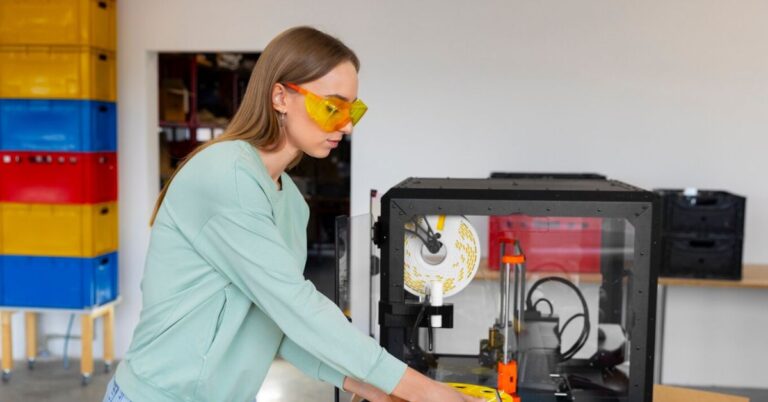The Bambu Lab A1 and A1 Mini are the most versatile 3D printers. These printers are known for their high-speed printing, along with stellar print quality. But to maximize your 3D printing quality, you must choose the right filament for your printer.
The whole debate about filament requires a lot of knowledge since simple choices can strongly impact the print strength, quality, durability, finish, and even the ease of printing. Therefore, this guide covers the complete Bambu Lab A1 filament compatibility along with the right temperature you should print it.
Filament Compatibility – Why is it a thing?
The Bambu A1 supports a wide range of filaments, so it can print a variety of materials. Whether you want to make functional parts or prototypes, this printer has you covered. Each filament contains unique material that affects the printer’s behavior during the printing process.
Moreover, different types of filaments are printed best at different temperatures, which is why understanding their compatibility with the A1 is so important. Some of the most commonly used filaments include PLA, ABS, PETG, ASA, Nylon, and Polycarbonate.
Some additional knowledge would be about the enclosure. Some filaments print the best with Bambu A1 Enclosure, which allows complete temperature control so your 3D printer can work properly. Brands such as Chitu Systems provide some of the best Bambu A1 Enclosures since the company behind the printer doesn’t have a product like this.
Now, let’s get into the topic.
PLA – The Best Beginners Filament
Polylactic Acid or PLA is the most commonly used filament for 3D printing in general. Thanks to its ease of printing, less warping, and the green nature, 3D printing enthusiasts love what it brings to the table.
Moreover, its compatibility with the A1 is elite, and it’s perfect for providing detailed outputs with smooth surfaces. So, if you’re looking for a filament that will give you that smooth finish, PLA is the way to go.
Talking about the settings, while PLA doesn’t need a heated bed, a temperature of 50-60°C is perfect for optimal adhesion. When it comes to the nozzle temperature, between 190-220°C works the best, but you should always look out for it.
PLA is perfect for making decorative items, prototypes, but it’s not perfect for printing at high temperatures.
ABS – The Durability King
Acrylonitrile Butadiene Styrene, also known as ABS, is known for being one of the most durable materials when it comes to 3D printing. It is durable and has great heat resistance, making it one of the best choices for printing mechanical and functional parts.
When it comes to the temperature, ABS has warping issues and even needs a heated bed at 90-100°C. To make things interesting, the nozzle temperature here should also be around 230-250°C for proper printing.
When you use an enclosure with ABS printing, you are going to reduce warping and cracking. Moreover, ABS also emits strong fumes, so a good ventilation system in your room is also required.
PETG – The Balance Between Strength and Flexibility
Polyethylene Terephthalate Glycol, or PETG, is often considered a mixture of ABS and PLA. It is an excellent filament that will give you flexibility, less brittleness, and resistance to chemicals and moisture.
If we’re talking about an all-rounder, PETG wins the hearts of many. If you want to print the best with this filament, you should have a temperature between 220-250°C and a bed temperature of 70-90°C.
However, the only con of PETG is that it is vulnerable to stringing, so you have to take care of each aspect of printing.
TPU: For Better Flexibility
Thermoplastic Polyurethane, also known as TPU, is one of the most flexible filaments that is known for creating things like wearable, mobile phone covers, and more. It is perfect for shock absorbing, which is why a lot of people love to make parts using it.
The nozzle temperature for this filament should be between 210-240°C, with a bed temperature of 40-60°C. You will be amazed to see how far TPU can go in terms of 3D printing.
ASA – The UV Resistance Filament
Acrylonitrile Styrene Acrylate or ASA is the ideal alternative to ABS, thanks to its UV-resistant nature. This filament doesn’t go yellow or degrade when it is exposed to sunlight. Moreover, just like ABS, it must be printed at a higher temperature, which is why it is perfect to print between 240-260°C.
The heating bed temperature for ASA is ideal between 90-110°C. All in all, ASA is an amazing tool for making items like automotive parts, outdoor tools, and a lot more.
Nylon – A Strong Filament
Nylon is known for being wear-resistant and is perfect for producing durable parts. From gears, hinges, and other mechanical supports to anything that requires a lot of durability, it is a great choice for anyone who is looking for an innovative solution.
However, a huge problem with Nylon is that it absorbs moisture way too quickly. That’s why it must be stored in a dry environment. When it comes to the temperature, it prints best between 240-270°C and a bed temperature of 80-110°C.
Many people use glue to stick Nylon since it can warp really easily.
Final Verdict
With so many filaments in the market, your choice must be according to your needs. We have mentioned the most common filaments for Bambu Lab A1 and their compatibility. By staying within the right settings, you will be able to get your 3D prints optimally.Moreover, if you’re looking for all types of 3D printing accessories, then you should visit Chitu Systems and their huge catalog of accessories.

